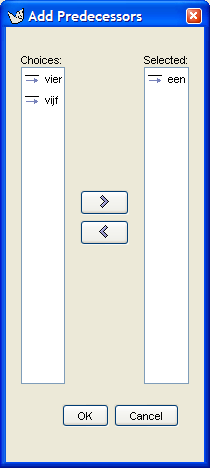A message is a communication between two instances of an
association role on a specification level collaboration
diagram. It describes an action which will generate the
stimulus associated with the message. On a collaboration
diagram a message is associated with an association role. In
the UML metamodel Message is a sub-class of
ModelElement.
The message is represented on a collaboration diagram in ArgoUML by its sequence number separated by a colon from the expression defining the associated action. It is accompagnied by an arrow pointing in the direction of the communication, i.e. the direction of the AssociationRole. By convention the name of a message is not shown on the diagram. Instead the diagram displays the message sequence number, either as an integer or as a decimal number to show hierarchy.
![[Warning]](images/warning.png) | Warning |
|---|---|
The current release of ArgoUML does not retaining message positioning after reloading the project, i.e. as if the positions were not stored in the project file. |
The details tabs that are active for messages are as follows.
ToDoItemStandard tab.
PropertiesSee Section 21.5.2, “ Message Property Toolbar ” and Section 21.5.3, “ Property Fields For Message ” below.
DocumentationStandard tab.
PresentationStandard tab. The values for the bounds of the message define the bounding box of the message. The
Linefield defines the arrow color. Increasing theShadowsize has an esthetically questionable effect.![[Caution]](images/caution.png)
Caution In the V0.18 release of ArgoUML changing the position of the message by editing the values of the
Boundsfield is possible, but will make only a temporary change to the position of the message, as described above.SourceStandard tab, showing the message number and action expression separated by a colon (when UML 1.4 is selected in the drop-down).
![[Caution]](images/caution.png)
Caution A message probably should not generated any code of itself. That should be left to the action and possibly stimulus associated with it. In any case changes to this tab are ignored.
Tagged ValuesStandard tab. In the UML metamodel,
Messagehas the following standard tagged values defined.derived(from the superclass,ModelElement). Valuestrue, meaning the message is redundant -it can be formally derived from other elements, orfalsemeaning it cannot.![[Note]](images/note.png)
Note Derived messages still have their value in analysis and design to introduce useful names or concepts, and in design to avoid re-computation.
![[Note]](images/note.png)
Note The UML
Elementmetaclass from which all other model elements are derived includes the tagged elementdocumentationwhich is handled by the documentation tab under ArgoUML

Go upNavigate up through the package structure.

New ActionThis creates a new Action (see Section 20.3, “ Action ”) for the selected object, navigating immediately to the properties tab for that action.

New StereotypeThis creates a new Stereotype (see Section 16.6, “ Stereotype ”) for the selected message, navigating immediately to the properties tab for that stereotype.

DeleteThis deletes the message from the model
![[Warning]](images/warning.png)
Warning This is a deletion from the model not just the diagram. To delete an message from the diagram, but keep it within the model, use the main menu
Remove From Diagram(or press the Delete key).
NameText box. The name of a message is usually its sequence number, either an integer, or a decimal (allowing alternative message hierarchies to be clearly described). ArgoUML will supply an integer sequence number by default.
StereotypeDrop down selector. Message has no stereotypes by default in the UML standard.
Navigate Stereotype icon. If a stereotype has been selected, this will
navigate to the stereotype property panel (see
Section 16.6, “
Stereotype
”).
icon. If a stereotype has been selected, this will
navigate to the stereotype property panel (see
Section 16.6, “
Stereotype
”).InteractionText box. Records the Interaction of which the message is a part.
Button 1 double click on the entry will navigate to the interaction.
SenderText box. Identifies the classifier role which sent this message.
Button 1 double click navigates to the sender classifier role.
ReceiverText box. Identifies the classifier role which receives this message.
Button 1 double click navigates to the receiver classifier role.
ActivatorDrop down selector. Identifies the message which invokes the behavior that causes the sending of this message.
Button 1 click allows selecting the message.
ActionText box. Lists the action (see Section 20.3, “ Action ”) this message invokes to raise a stimulus.
Button 1 double click navigates to the selected action, button 2 gives a pop up menu with the following entry.
New. Add a new action.This item is downlighted if an action already exists.
PredecessorsText area. Identifies the messages, the completion of whose execution enables this message.
Button 1 double click navigates to the selected message, button 2 gives a pop up menu with one entry.
